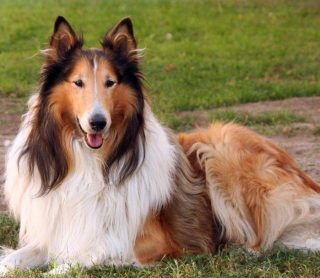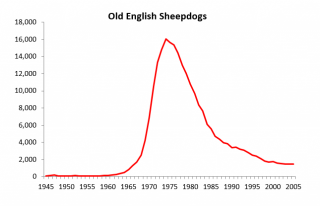Cross-Cultural Psychology
The Dog Movie Star Effect: Is It Real?
You think that Disney movies affect dog popularity -- but is it really true?
Posted September 10, 2014

In 1943, MGM released the movie Lassie Come Home. It was a big hit and was nominated for an Academy Award. The film was subsequently followed by a shift in the collective preferences of Americans for dogs. In the three years after the release of the movie, the number of annual Collie registrations with the American Kennel Club jumped from about 2,000 to over 15,000 puppies a year. But was this sudden increase in the desire to live with a collie a coincidence or was it the result of a “dog movie star effect” whereby some films featuring dogs produce massive shifts in our collective decisions about what type of pet we want to live with?
Clearly, media exposure does not automatically create canine fads. Between 1997 and 2000, Taco Bell ran an advertising blitz featuring a Spanish-speaking Chihuahua named Gidget (“Y quiero Taco Bell”). The ad campaign had no impact on the breed’s popularity. In fact, AKC Chihuahua registrations dropped nearly 50% over the next couple of years. And, my colleague Steve Elias and I discovered that being named Best in Show at the prestigious Westminster Kennel Club Dog Show usually has no effect on the popularity of the winning breed (see here).
While conventional wisdom holds that movies featuring a dog are often followed by a jump in the breeds’ popularity, this idea has never been empirically tested – until now. In research recently published in the journal PLOS One, Stefano Ghirlanda of Brooklyn College and Alberto Acerbi of the University of Bristol and I addressed several questions related to the impact of movies on our choice of pets. Is there actually a dog movie star effect? If so, how much impact do dog movies have? And, how long does the effect last?
Using Big Data To Study The Impact of Dog Movie Stars
Increasingly, scientists are using what is called “big data” to explore the impact of the media on our behavioral choices such as what we name our kids, the books we read, and the music we listen to. Our big data consisted of 65 million puppies registered with the American Kennel Club between 1927 and 2005. We located 87 movies featuring dogs, of which 63 breeds were included in the AKC database. After eliminating movies in which dogs were not the main characters and a few sequels and movies in which dogs were villains, we were left with 29 dog movies for our analyses.
Simply looking at the impact of movies on registration numbers could be misleading as a breed’s popularity could be on the upswing when the film came out. Rather, we asked what effect dog movie stars have on trends in a breed’s popularity. So, if a breed was already trending upward when the movie was released, we wanted to know if puppy registrations suddenly began to accelerate at a higher rate than would be predicted by puppy registrations over the previous ten years.
The Results.
Here are the highlights of our findings. (For the details, click here for a copy of the PLOS One paper.)

The impact of The Shaggy Dog on English Sheepdog Registrations
1. The dog movie star effect is real. Among the 29 films, the overall popularity of breeds as reflected by AKC puppy registrations did increase at a greater-than-expected rate in the years following the release of the movies. (Jumps in breed popularity, however, did not occur in all cases. For example, Cairn terrier registrations declined after the 1939 release of The Wizard of Oz, despite the presence of role of Dorothy’s darling little pooch Toto.)
2. Dog movie star effects could be surprisingly long-lasting. We found that movies sometimes had an impact on breed popularity ten years after the initial release of a film.
3. The effect can be large. The 1959 Disney movie The Shaggy Dog was followed by a 100-fold increase in annual Old English Sheep Dog AKC puppy registrations. We found that the ten movies with the biggest impact resulted in a total of 800,000 additional puppy registrations for these movie star breeds.
4. The more people who see a film, the bigger the impact of the movie star effect. In fact, the number of viewers during a movie’s opening weekend predicted new puppy registrations ten years later.
5. The strength of the dog movie star effect appears to be declining. We found that high-profile canine actors had a greater impact on dog breed popularity in the early and mid-twentieth century than it has now. Why should this be the case? One possibility is that cinema generally has less impact on popular culture now than it did 50 or 60 years ago because of competition with other forms of entertainment such as television and the Internet. Another possibility is that the size of the effect has been diluted by an increase in the number of dog films. Between 1927 and 1940, roughly one movie a year starring a dog was released in the United States. Now, however, seven films or more featuring dogs are typically released each year.
The Real Importance of Our Study
You might be thinking, big deal…everyone knows that movies affect the popularity of dog breeds. The importance of this research not just that it is the first actual demonstration of the dog movie star effect. As Stefano wrote, “Ours is the first study to assess the impact of movies over many decades, and the first to study a behavior – choice of dog breed – that is subject to the erratic fluctuations typical of fashions and fads.”
Who knew, for example, that decisions about pets could reflect the impact of a film that came out ten years previously? And I certainly didn’t expect to find that movies have less effect on American popular culture today than they did 50 years ago.
The PLOS One paper is the most recent of eight research reports my colleagues and I have now published on the dynamics of changes in dog breed popularity in the United States. At one level, this series of studies is about how people pick their pets (see the list of articles below). But to me, the real significance of our research is that it demonstrates how non-rational factors such as imitation, status envy, and random chance can have huge effects on both personal decision-making and widespread changes in popular culture.
Gotta go now...a rerun of Old Yeller is on the tube tonight.
* * * * * *
For previous Animals and Us posts on our relationships with dogs see here and here.
Here is a list (in chronological order) of our articles on how shifts in dog breed popularity can be used to study the dynamics of cultural change:
Herzog, H. A., Bentley, R. A., & Hahn, M. W. (2004). Random drift and large shifts in the popularity of dog breeds. Biology Letters: Proceedings of the Royal Society, 271 Suppl 5, S353-6. doi:10.1098/rsbl.2004.0185 [doi] (here) [
Herzog, H. A., & Elias, S. M. (2004). Effects of Winning the Westminster Kennel Club Dog Show on breed popularity. Journal of the American Veterinary Medical Association, 225(3), 365-367. (here)
Herzog, H. (2006). Forty-two thousand and one Dalmatians: Fads, social contagion, and dog breed popularity. Society and Animals, 14(4), 383. (here)
Bentley, R. A., Lipo, C. P., Herzog, H. A., & Hahn, M. W. (2007). Regular rates of popular culture change reflect random copying. Evolution and Human Behavior, 28(3), 151-158. (here)
Acerbi, A., Ghirlanda, S., & Enquist, M. (2012). The logic of fashion cycles. PloS One, 7(3), e32541. (here) ]
Ghirlanda, S., Acerbi, A., Herzog, H., & Serpell, J. A. (2013). Fashion vs. function in cultural evolution: The case of dog breed popularity. PloS One, 8(9), e74770. (here)
Herzog, H. (2014). Biology, culture, and the origins of pet-keeping. Animal Behavior & Cognition, 1(3), 296-308. (here)
Photo credits:




